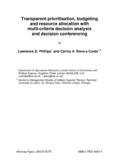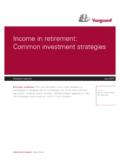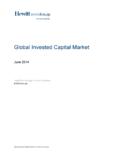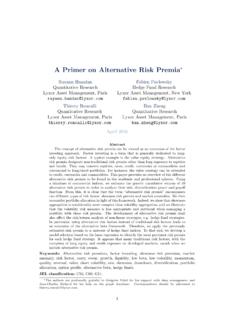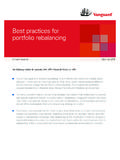Transcription of Benchmarking Private Equity Performance - Signal …
1 Benchmarking Private Equity Performance8 June 2007 EVCA Institute Finance & Administration Course, NiceDavid What are we measuring and why is it so difficult? What/how do we benchmark? What are the actual results for the industry?2 Current Environment Increased transparency of the asset class for fund raising, fund reporting, asset allocation and fund due diligence, as well as individual transactions Less disclosure around individual fund returns, and impact of FOIA Confusion: What is the return being reported? How was it derived?
2 How can you put it in context? Valuation guidelines ( ) being adopted and endorsed internationally, including ILPAPart 1 What are we measuring and why is it so complicated?4Is a return of 200% good enough? A return of 200%? 200% total return: having invested 1m, we get 2m back 200% percentage change: we get 3m back (let s assume this) Over what time period? Over two years -- great at 73% per year ( ^2=3) Over ten? --- hmmm!! At per year ( ^10=3) Is it return on the investments the fund made or is it the return to the investors in the fund?
3 Is it the return of a single fund or the return of a portfolio of funds? IRR Since Inception / Investment Horizon IRR / Time-Weighted IRR / Realised Multiple / Unrealised Multiple?5 Why an IRR? Why the difference with most stock indices? You can t just look at the value at two points in time, today and some point in the past, with no transactions or cashflows in between it would assume that you buy and hold You don t invest the money all at once, and you also take money out over a period of time With investments either in Private Equity or any investment manager, if you have cashflows in and out of an investment, simple percentage change/total return calculations can no longer be done to get the true Return On Investment So we turn to IRR*.
4 A form of ROI that takes the time value of money into account as it accounts for the timing of the transactions in the investment* AIMR, GIPS, standard practicePart 2 What/how do we benchmark?7 Why a benchmark? Return is mathematical algorithm it is an absolute measure Performance is a relative measure can only be determined by comparing return to something else for example past returns, benchmarks, etc. So you need a benchmark8 Why a benchmark? The Na ve Investor example Investor has choice of 2 investments. Other things being equal, with no additional information, optimal allocation for na ve manager is 50-50 So any decision you make different than this should be better Performance so benchmark is Performance of 50-50 allocation .
5 You are Benchmarking the decision of the allocation That s why public indices is used so often in stock market benchmarks it s the na ve manager decision Any investment decision you make different than allocation to, say, S&P500 should be better if you are worth the fees you are being paid9 Whose decision are you Benchmarking ? Several decisions to benchmark for the LP investor The allocation to Private Equity The allocation between Private Equity sub asset classes The timing decision of when to invest The Performance of your portfolio The decision of one manager over the other (The portfolio company investment decision of the fund)
6 Several decisions to benchmark for the GP investor The timing decision of when to raise a fund The Performance of your funds The portfolio company investment decision of the fund10 Principal benchmarks Cumulative IRR Cumulative Realisation Multiples Time Weighted Return Investment Horizon Return Public Market Comparables Index method11 Some definitions (1/2)Limited PartnersLimited PartnersPrivate Equity Firm (General Partners) Private Equity Firm (General Partners)Fund IFund IFund IIFund IICompany 1 Company 1 Company 2 Company 2 Cash take-downCash/stock distribution Takedown: actual money paid into partnerships, capital calls, paid in capital Distributions: cash or stock returned to LP investors NAV(net asset value*), residual value: ending value of the fund for the period being measured net of carry Vintage Year: year fund had first cash flow Pooled Return.
7 Portfolio return by pooling cashflows of several fundsManagement feesCarry* as calculated and reported by the GPsInvestmentsDivestments12 Some definitions (2/2)IRRs in decreasing orderMaximum IRR (best fund)Upper QuartileMedianLower QuartileMinimum IRR (worst fund)Top Quarter2nd Quarter3rd Quarter4th Quarter13r-iFund Returns CalculationsCash / stock returns to investors = Distribution Invested capital = Paid-In time Principal metric is IRR since inception calculated net to limited partner. Beginning point is fixed, endpoint is variable The IRR is calculated as an annualised effective compounded rate of return using daily cash flows and annual/quarterly valuations.
8 The IRR is the return (discount rate) that will equalise the present value of all invested capital with the present value of all returns, or where the net present value of all cash flows (positive and negative) is zero:where CFi is the cash flow for period i (negative for takedowns, positive for distributions) The IRR of an active fund is therefore dependent on the fund valuationNAV14 Typical Fund Cashflow - Simple Example of IRR CalculationYearTakedownsDistribution sNAV1992(5, )5, (12, )17, (15, )32, (5, )7, , (5, )73, (7, )30, , , , , , + IRR1995+-12, (1 + IRR1995 )2+ (1 + IRR1995 )3=0-5, + 7, + 49, +Column ARow 1(5, )Row 2(12, )Row 3(15, )Row 452, RAW DATATHE CALCULATION IN MS EXCELTHE FORMULA=irr(A1:A4,0)=.
9 In this example, we are calculating an IRR based on a net cash flow for the year rather than daily or monthly cash flows, which is a very simplistic approach and used only for illustration purposes15 Cashflows for Cumulative ReturnsCF series to 1993CF 1994CF 1995CF 1996CF 1997CF 1998CF 19991992(5, )(5, )(5, )(5, )(5, )(5, )(5, )19934, (12, )(12, )(12, )(12, )(12, )(12, )199416, (15, )(15, )(15, )(15, )(15, )199552, , , , , , (5, )(5, )(5, )199789, , , , , , of actual annual cash flows with NAV added as a positive cash flow in last year17, -12, MultiplesCash / stock returns to investors = Distribution Invested capital = Paid-In time DPI = Distributions / Paid-In Ratio, realised multiple RVPI = Residual Value / Paid-In Ratio, unrealised multiple TVPI = Total Value / Paid-In Ratio = DPI + RVPI17 Realisation MultiplesDPI = Distributions / Paid In Ratio, realised multiple RVPI = Residual Value / Paid In Ratio.
10 Unrealised multiple TVPI = DPI + RVPIYearTakedownsDistributionsNAVC umulative IRRDPIRVPITVPI1992(5, )5, (12, )17, (15, )32, (5, )7, , (5, )73, (7, )30, , , , , , ) What is the DPI as of 31/12/1995?2) What is the RVPI as of 31/12/1996? 18 Realisation MultiplesYearTakedownsDistributionsNAVC umulative IRRDPIRVPITVPI1992(5, )5, (12, )17, (15, )32, (5, )7, , (5, )73, (7, )30, , , , , , , + 12, + 15, + 5, , , + 12, + 15, + 5, + 5, , Weighted Returns Time weighted return calculates a return for each period quarterly, annually Beginning point is variable, endpoint is variable Calculate using net asset value at beginning and end of period and cashflows between periods Calculate IRR for each period and then compound together Shortfalls Creates aberrations: 100 + 20% = 120 120 - 20% = 96 Returns heavily dependent on valuations.
